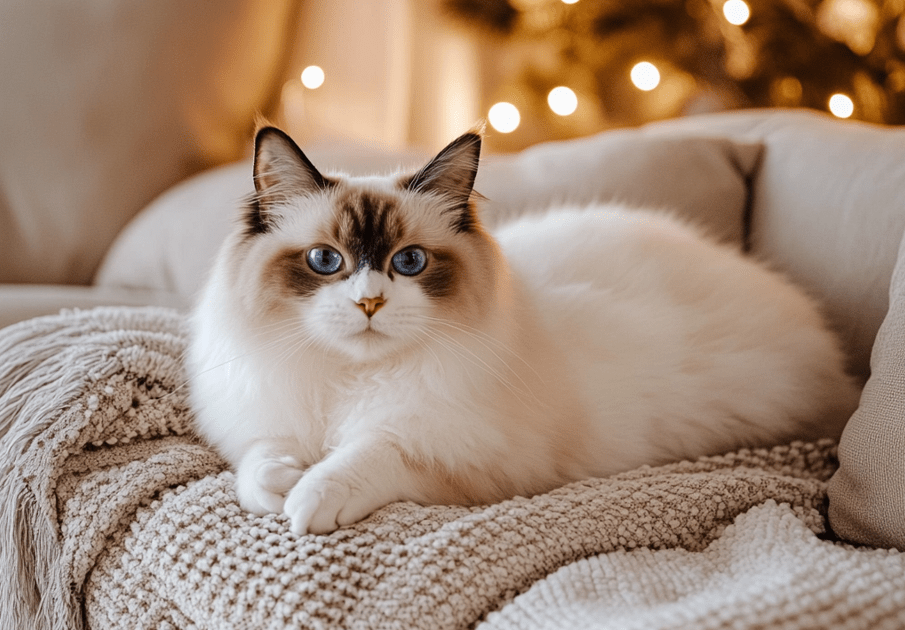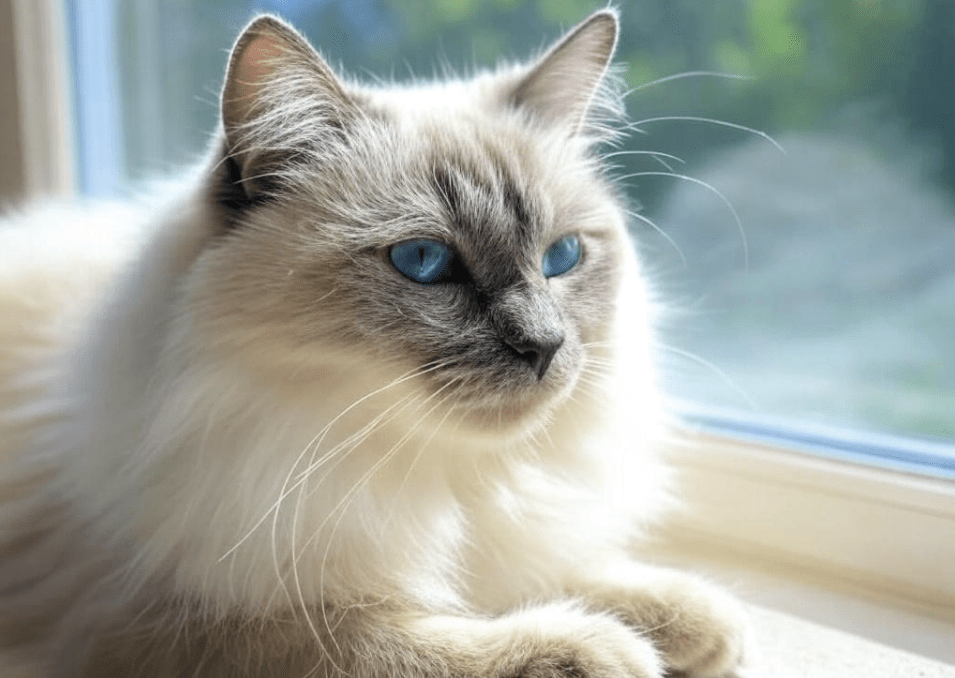
Ragdoll cats, with their luxurious coats and affectionate nature, are cherished companions. However, their thick fur makes them susceptible to fleas, which can cause discomfort and health issues. Knowing how to treat fleas on your Ragdoll cat early is crucial for their well-being. This comprehensive guide covers how to identify flea infestations, effective treatment methods, and preventive measures tailored to Ragdolls. By catching fleas early and using safe, budget-friendly solutions, you can keep your feline friend healthy and happy. Let’s dive into everything you need to know about flea control for Ragdolls.
Why Fleas Are a Concern for Ragdoll Cats
Ragdolls’ long, dense coats provide an ideal hiding spot for fleas, making infestations harder to detect. Fleas are tiny, wingless parasites that feed on your cat’s blood, causing itching, irritation, and potential health complications like:
Skin Infections: Excessive scratching can lead to bacterial infections.
Flea Allergy Dermatitis (FAD): Some Ragdolls are allergic to flea saliva, resulting in intense itching and hair loss.
Anemia: Severe infestations can cause blood loss, especially in kittens or senior cats.
Tapeworms: Fleas can carry tapeworm larvae, which cats ingest while grooming.
Early detection and treatment are essential to prevent these issues, particularly for Ragdolls, whose calm demeanor might mask discomfort until the problem worsens.
How to Spot Fleas on Your Ragdoll Cat
Detecting fleas early is the first step to effective treatment. Here’s how to identify an infestation on your Ragdoll:
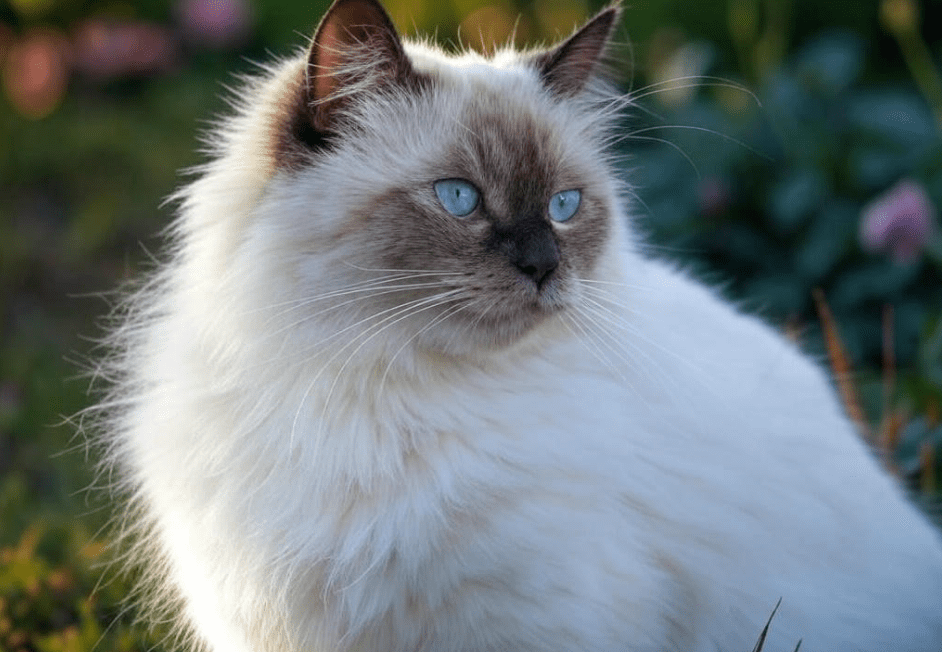
1. Watch for Behavioral Changes
Fleas cause discomfort, leading to noticeable changes in your cat’s behavior:
Excessive Scratching or Grooming: Ragdolls may scratch their neck, back, or base of the tail excessively.
Restlessness: Your normally relaxed Ragdoll may seem agitated or unable to settle.
Biting or Chewing: Cats often nibble at flea-infested areas, especially around the hindquarters.
2. Inspect Their Coat and Skin
Ragdolls’ thick fur requires thorough checks:
Part the Fur: Use your fingers or a fine-tooth flea comb to inspect the skin, focusing on the neck, back, and base of the tail.
Look for Flea Dirt: Flea feces appear as small black or reddish-brown specks. To confirm, place specks on a damp paper towel; if they turn red, it’s flea dirt (digested blood).
Check for Fleas: Adult fleas are tiny (1–2 mm), dark brown, and fast-moving. You may see them darting through the fur.
Examine the Skin: Look for redness, scabs, or hair loss, which indicate irritation or FAD.
3. Monitor for Physical Signs
Fleas can cause visible health changes:
Hair Loss: Patchy fur, especially around the tail or back, may signal flea-related scratching.
Skin Lesions: Small sores or hot spots can develop from constant scratching.
Pale Gums: In severe cases, anemia from blood loss may cause pale gums, lethargy, or weakness.
4. Check Their Environment
Fleas thrive in your cat’s surroundings:
Bedding and Furniture: Inspect your Ragdoll’s favorite spots for flea dirt or eggs (tiny white specks).
Carpets and Rugs: Fleas lay eggs in soft surfaces, which can reinfest your cat if not addressed.
Tools for Detection
Flea Comb: A fine-tooth comb designed to trap fleas and flea dirt.
Magnifying Glass: Helps identify tiny fleas or eggs.
White Towel: Place your cat on a white surface while combing; fleas and dirt are easier to spot.
How to Treat Fleas on Your Ragdoll Cat
Once you confirm a flea infestation, prompt action is key to relieving your Ragdoll’s discomfort and preventing reinfestation. Here are safe, effective methods to treat fleas on your Ragdoll cat:
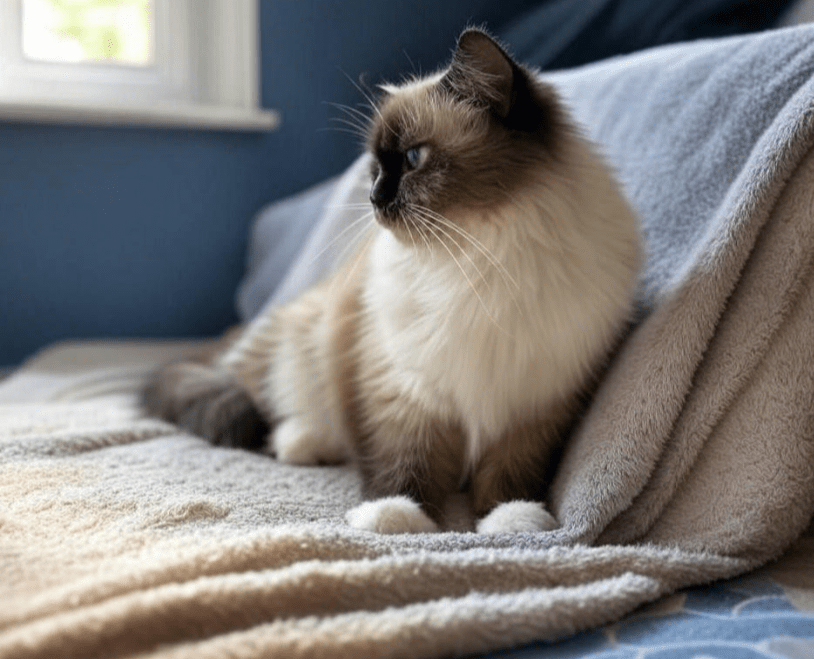
1. Topical Flea Treatments
Topical treatments are applied to your cat’s skin and kill fleas on contact:
How It Works: Products like fipronil or selamectin (e.g., Frontline, Revolution) are applied to the back of the neck, spreading through the skin’s oils to kill adult fleas and prevent egg hatching.
Ragdoll Considerations: Choose vet-recommended products safe for long-haired cats. Avoid over-the-counter brands with harsh chemicals like permethrin, which can be toxic.
Application Tips:
1.Part the fur to ensure the product reaches the skin.
2.Follow dosage instructions based on your cat’s weight.
3.Monitor for side effects like lethargy or skin irritation.
Cost: $10–$20 per dose, lasting 1–3 months.
2. Oral Flea Medications
Oral treatments are fast-acting and ideal for Ragdolls who dislike topical applications:
How It Works: Medications like nitenpyram (Capstar) or spinosad (Comfortis) kill adult fleas within hours. Some also prevent larvae development.
Ragdoll Considerations: Consult your vet, as some oral treatments aren’t suitable for kittens or cats with health issues.
Administration Tips:
1.Hide the pill in a treat or use a pill pocket for easy dosing.
2.Combine with environmental control to prevent reinfestation.
Cost: $5–$15 per dose, depending on the brand.
3. Flea Shampoos
Flea shampoos kill fleas on contact but are a short-term solution:
How It Works: Shampoos with ingredients like pyrethrins or essential oils (e.g., Adams Flea & Tick Shampoo) remove adult fleas and soothe irritated skin.
Ragdoll Considerations: Ragdolls may resist baths due to their long fur. Use a gentle, cat-specific shampoo and avoid human or dog products.
Bathing Tips:
1.Use lukewarm water and a calm environment.
2.Comb out fleas with a flea comb during the bath.
3.Dry your Ragdoll thoroughly to prevent chills.
Cost: $8–$15 per bottle.
4. Flea Combs
A non-chemical option for mild infestations:
How It Works: Combing removes adult fleas, eggs, and flea dirt from your Ragdoll’s coat.
Ragdoll Considerations: Ideal for early infestations or as a maintenance tool. Combing also helps monitor flea activity.
Combing Tips:
1.Use a fine-tooth flea comb and work in small sections.
2.Dip the comb in soapy water to drown fleas.
3.Comb daily until no fleas are found.
Cost: $5–$10 for a quality comb.
5. Natural Remedies (With Caution)
Some owners prefer natural methods, but they require careful use:
Diatomaceous Earth (DE): Food-grade DE can be lightly dusted on your cat’s coat to dehydrate fleas. Avoid inhalation and use sparingly.
Essential Oils: Oils like cedarwood or lavender may repel fleas but must be diluted and vet-approved, as many are toxic to cats.
Apple Cider Vinegar: Diluted vinegar (1:3 with water) can be sprayed on bedding to repel fleas but isn’t effective on cats directly.
Ragdoll Considerations: Ragdolls’ sensitive skin requires extra caution with natural remedies. Always consult a vet before use.
Cost: $5–$15 for supplies.
Treating Your Home and Environment
Fleas spend only 10–20% of their life on your cat; the rest is in your home. To fully treat fleas on your Ragdoll cat, you must address their environment:
1. Vacuum Thoroughly
What to Do: Vacuum carpets, rugs, furniture, and your Ragdoll’s bedding daily to remove eggs, larvae, and pupae.
Tips:
1.Use a vacuum with a HEPA filter to trap fleas.
2.Dispose of the vacuum bag or clean the canister immediately.
Cost: Free (using your vacuum).
2. Wash Bedding and Fabrics
What to Do: Wash your cat’s bedding, blankets, and any washable furniture covers in hot water (at least 140°F) to kill fleas and eggs.
Tips:
1.Dry on high heat for at least 20 minutes.
2.Repeat weekly during treatment.
Cost: Minimal (detergent and utilities).
3. Use Flea Sprays or Powders
What to Do: Apply pet-safe flea sprays or powders (e.g., Vet’s Best Flea & Tick Spray) to carpets, furniture, and baseboards.
Tips:
1.Choose products labeled safe for cats.
2.Keep your Ragdoll out of treated areas until dry.
Cost: $10–$20 per product.
4. Consider Professional Pest Control
For severe infestations, hire a pet-safe exterminator to treat your home. Costs range from $100–$300, depending on the home’s size.
Preventing Future Flea Infestations
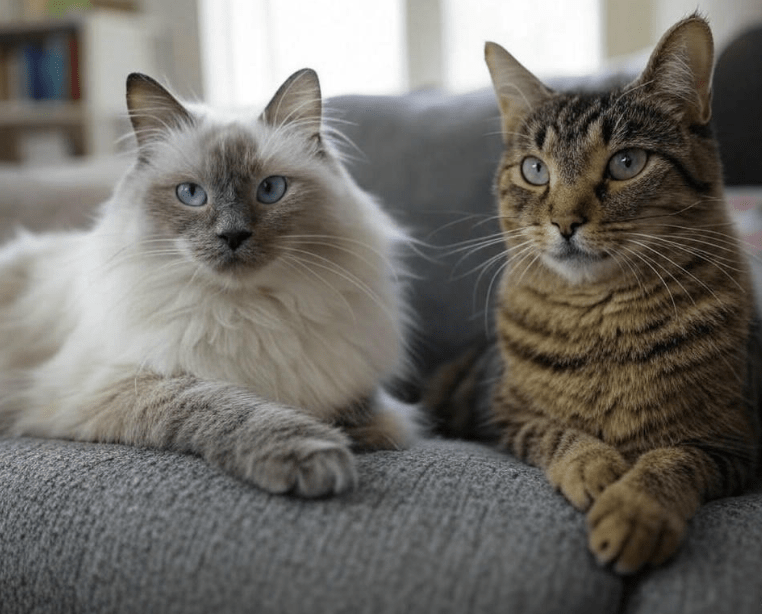
Prevention is easier and cheaper than treatment. Here’s how to keep fleas off your Ragdoll:
1. Regular Flea Preventatives
1.Use vet-recommended topical or oral preventatives year-round, even for indoor cats.
2.Popular options: Revolution, Advantage II, or Bravecto.
3.Cost: $10–$20/month.
2. Maintain a Clean Environment
1.Vacuum weekly and wash bedding regularly.
2.Use flea traps (sticky pads with a light source) to monitor for fleas.
3.Cost: $10–$15 for traps.
3. Groom Your Ragdoll
1.Brush your Ragdoll’s coat 2–3 times weekly to check for fleas and remove loose fur where fleas hide.
2.Use a flea comb monthly as a preventive check.
3.Cost: Free (using existing tools).
4. Limit Outdoor Exposure
1.Keep your Ragdoll indoors to reduce flea exposure.
2.If they go outside, check their coat after each outing.
5. Monitor for Reinfestation
1.Comb your Ragdoll weekly and watch for scratching or flea dirt.
2.Act immediately if signs reappear to prevent a full infestation.
Special Considerations for Ragdoll Cats
Ragdolls have unique traits that affect flea treatment:
Long Fur: Their dense coat hides fleas, requiring thorough checks and grooming.
Sensitive Skin: Avoid harsh chemicals or untested natural remedies to prevent irritation.
Calm Temperament: Ragdolls may tolerate treatments well but can become stressed by baths or frequent handling. Use gentle methods and reward with treats.
Health Sensitivities: Consult your vet before starting any treatment, especially for kittens, seniors, or cats with medical conditions.
When to See a Veterinarian
While many flea treatments are DIY, some situations require professional help:
Severe Infestations: If fleas persist after 2 weeks of treatment, a vet can prescribe stronger medications.
Flea Allergy Dermatitis: Itchy, red skin or hair loss may need antihistamines or steroids.
Anemia or Tapeworms: Pale gums, lethargy, or visible worms require immediate vet attention.
Kittens or Sick Cats: Young or ill Ragdolls need specialized treatments to avoid toxicity.
Your vet can also recommend safe products and check for underlying issues caused by fleas.
Budget-Friendly Tips for Flea Control
Treating fleas doesn’t have to be expensive. Here are cost-saving strategies:
Buy in Bulk: Purchase multi-month packs of preventatives for discounts.
Use Household Items: Vacuuming and washing bedding are free and effective.
DIY Flea Traps: Place a dish of soapy water under a nightlight to trap fleas overnight.
Shop Smart: Compare prices online or ask your vet for generic alternatives.
Conclusion
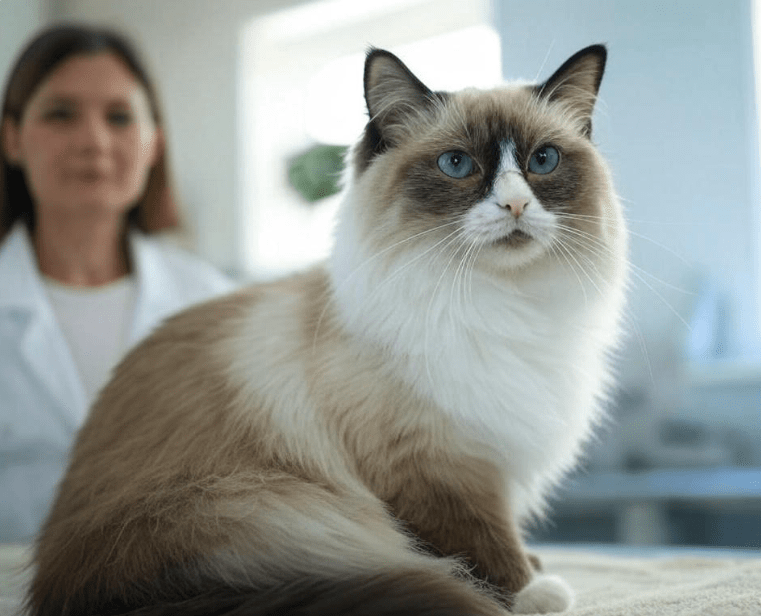
Fleas are a common but manageable issue for Ragdoll cats. By learning how to treat fleas on your Ragdoll cat early, you can protect their health and comfort. Start with regular inspections to catch infestations before they worsen, use safe treatments like topical or oral medications, and maintain a clean environment to prevent reinfestation. With tailored care for your Ragdoll’s unique needs, you can keep their coat flea-free and their spirits high. Act promptly, stay consistent, and consult your vet when needed to ensure your Ragdoll thrives flea-free.


